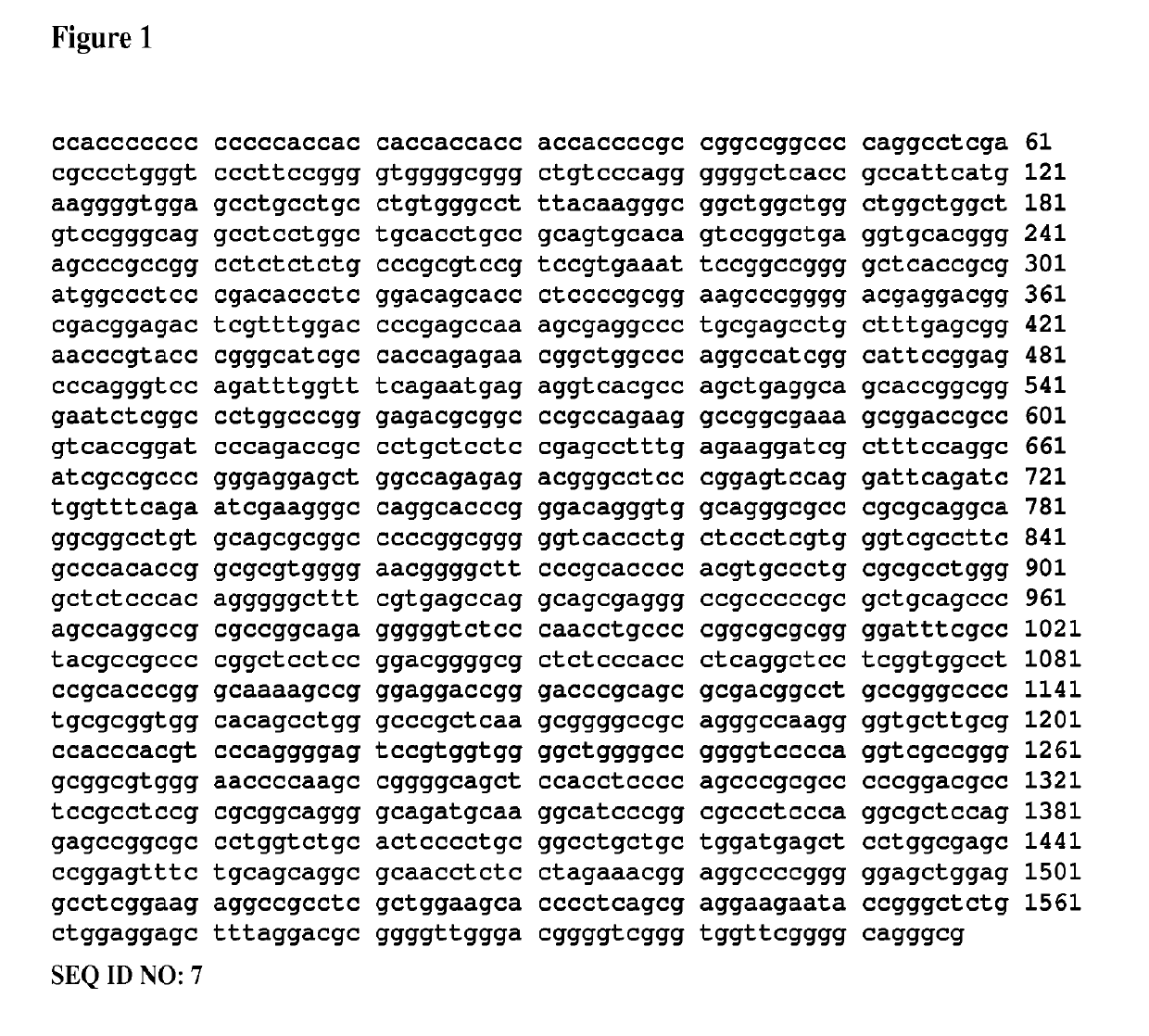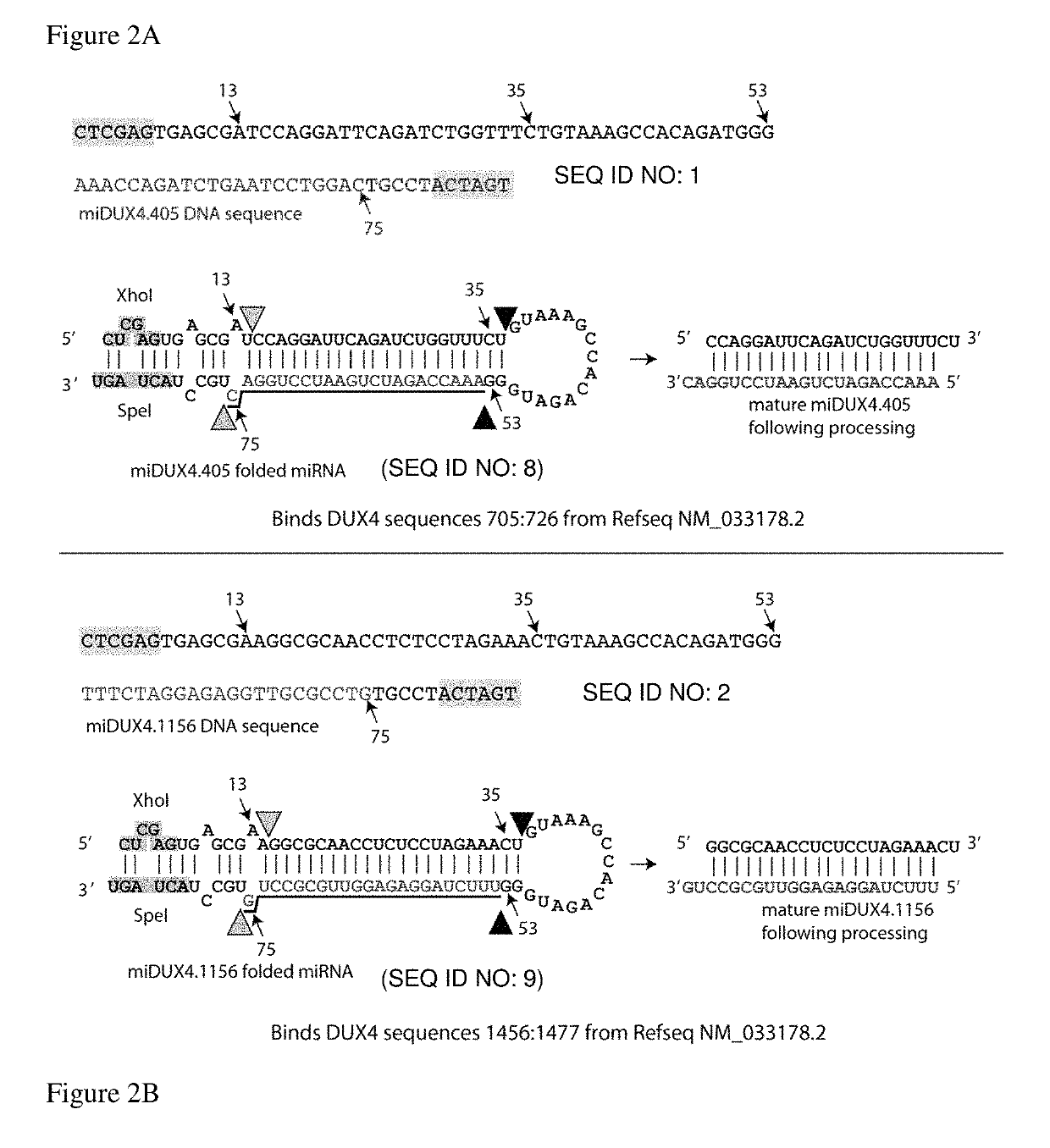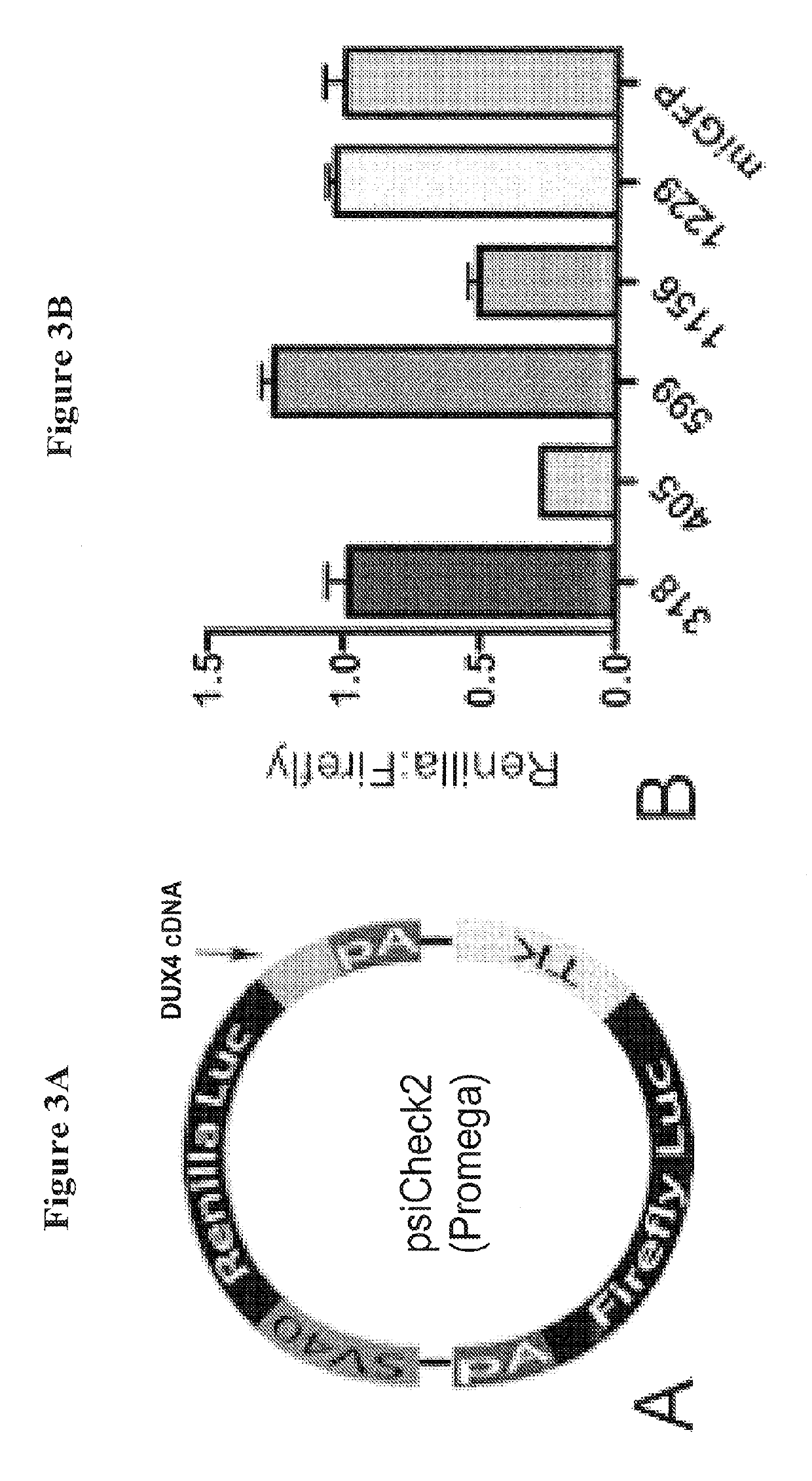Recombinant virus products and methods for inhibition of expression of DUX4
a technology of recombinant viruses and products, applied in the field of rna interference, can solve the problems of unresolved pathogenic mechanisms, aav-infected cells are not resistant to superinfection, and their worldwide incidence may be underestimated, so as to achieve the effect of convenient administration and handling
- Summary
- Abstract
- Description
- Claims
- Application Information
AI Technical Summary
Benefits of technology
Problems solved by technology
Method used
Image
Examples
example 1
MicroRNAs Specific for the DUX4 Gene
[0050]Two miRNAs specific for the DUX4 gene were generated by PCR. Four PCR primers were used that had the following sequences.
[0051]
Primer 662 (miDUX4hum405F):(SEQ ID NO: 3)AAAACTCGAGTGAGCGATCCAGGATTCAGATCTGGTTTCTGAAAGCCACAGATGGGPrimer 663 (miDUX4hum405R):(SEQ ID NO: 4)TTTTACTAGTAGGCAGTCCAGGATTCAGATCTGGTTTCCCATCTGTGGCTTTCAGPrimer 665 (miDUX4hum1156F):(SEQ ID NO: 5)AAAACTCGAGTGAGCGAAGGCGCAACCTCTCCTAGAAACTGAAAGCCACAGATGGGPrimer 667 (miDUX4hum1156R):(SEQ ID NO: 6)TTTTACTAGTAGGCACAGGCGCAACCTCTCCTAGAAACCCATCTGTGGCTTTCAG
[0052]DNA encoding a miRNA designated hDux.mi405 was generated using primers 662 and 663. DNA encoding miRNA designated hDux.mi1156 was generated using primers 665 and 667.
[0053]One μg of each primer was added to a 1 cycle primer extension reaction: 95° C. for 5 min.; 94° C. for 2 min.; 52° C. for 1 min.; 72° C. for 15 min.; and then holding at 4° C. The PCR products were cleaned up with the Qiagen QIAquick PCR Purification kit before b...
example 2
Luciferase Assay for Effect of Expression of DUX4 miRNAs
[0056]Expression of the DUX4 target sequence in the presence of the DUX4 miRNAs was assayed. A lipofectamine 2000 transfection was done in 293 cells in a 96-well, white-walled assay plate. 140,000 cells were transfected with 20 ng of a Renilla-firefly plasmid containing the DUX4 target sequence (FIG. 3A) and 180 ng of various DUX4 miRNA-encoding vectors, including U6T6-driven miDux4.405 or miDux4.1156 vectors from Example 1. A luciferase assay was performed 24 hours later.
[0057]The media was removed from the cells and 20 μl of lysis buffer was added per well. The plate was put on a shaker for 15 minutes at room temperature before adding 50 μl of luciferase substrate. The first reading was taken 10 minutes later. Next, 50 μl of Stop and Glo luciferase substrate was added and the second reading was taken 10 minutes later. The Renilla expression was divided by the firefly expression to calculate the relative expression. The relati...
example 3
Western Blot Assay for Effect of Expression of DUX4 miRNAs from rAAV
[0058]Next, the U6T6.miDUX4 miRNA expression cassettes were cloned into AAV.CMV.hrGFP proviral plasmids as shown in the FIG. 4A. The proviral plasmids were then co-transfected with a DUX4.V5 expression plasmid into 293 cells and the effect of expression of DUX4 miRNAs from the proviral plasmids was assayed by Western blot. A U6.miGFP sequence, which does not target DUX4, was used as a negative control for gene silencing.
[0059]One day before transfection, 293 cells were plated in a 24-well plate at 1.5×105 cells / well. The cells were then transfected with AAV-CMV-DUX4-V5 and AAV-CMV-miDUX4 (405 or 1156) using Lipofectamine 2000 (Invitrogen, Cat. No. 11668-019):[0060]Group 1: AAV-CMV-DUX4-V5 50 ng+AAV-CMV-miDUX4 800 ng (1:16)[0061]Group 2: AAV-CMV-DUX4-V5 100 ng+AAV-CMV-miDUX4 800 ng (1:8)
[0062]Thirty-six h after transfection, cells were collected and washed with cold PBS once. Seventy μl lysis buffer (137 mM NaCl, 10 ...
PUM
| Property | Measurement | Unit |
|---|---|---|
| pH | aaaaa | aaaaa |
| length | aaaaa | aaaaa |
| lifetime | aaaaa | aaaaa |
Abstract
Description
Claims
Application Information
 Login to View More
Login to View More - R&D
- Intellectual Property
- Life Sciences
- Materials
- Tech Scout
- Unparalleled Data Quality
- Higher Quality Content
- 60% Fewer Hallucinations
Browse by: Latest US Patents, China's latest patents, Technical Efficacy Thesaurus, Application Domain, Technology Topic, Popular Technical Reports.
© 2025 PatSnap. All rights reserved.Legal|Privacy policy|Modern Slavery Act Transparency Statement|Sitemap|About US| Contact US: help@patsnap.com



